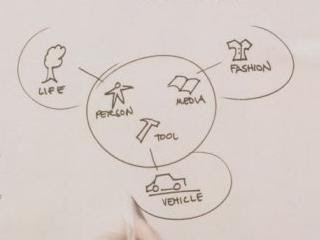 Bill Moggridge's presentation entitled Contexts for design in a connected world was a catalog of examples. He opened it with a statement on design " it is about people, environment and the world in which we live".
Bill Moggridge's presentation entitled Contexts for design in a connected world was a catalog of examples. He opened it with a statement on design " it is about people, environment and the world in which we live".He illustrated differences in people with the example of an early mobile payment system at a vending machine in Japan. It showed a user respectful of machines and happy to fiddle and push keypads. Japanese are trained to this during their long commute to work, but they would not talk much. Oppositely, he said Americans would enjoy phone conversations or voice-activated applications while driving their car.
The social environment is changing too : "in the the previous century, we designed things, in the current century we design for health". "Architects were designing buildings and now they design social interaction spaces". And we now look at social impact around the world. For example IDEO designed tools to help design for those "at the bottom of the pyramid" (the less developed world). These tools are available on-line, the work was sponsored by the Gates foundation.
He commented on designing for sustainability: "that used to be about materials but now about it is about designing lifestyles". We looked at a video of Tangible Earth, an interactive digital globe designed by Shin-ichi Takemura to visualize global warming and other changes occurring in real-time or in the future on the planet.
Space, people and prototypes

- Look : have teams stay when it is happening, like a fly on the wall
- Ask : foreign correspondents around the world provide 24 hours response
- Try : get people to try prototypes "wear thick glove when using phones in cold weather"
The theme of the presentation was very similar to stories in Bill Moggridge's book "Designing interaction" where he introduces 40 case-studies from designers, describing the evolution from inspiration to products.


